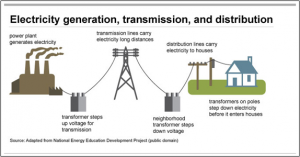WHAT INFRASTRUCTURE IS IN PLACE FOR HYDRO?
The Electric Power Grid
In the continental United States, the electric power grid, a system of synchronized power providers and consumers connected by transmission and distribution lines, consists of three systems: 1) the Eastern Interconnect, 2) the Western Interconnect, and 3) the Texas Interconnect. In Alaska and Hawaii, several systems encompass areas smaller than the state.[4]
In 2021, hydroelectricity accounted for approximately 6.3% of total US utility-scale electricity generation and 31.5% of total utility-scale renewable electricity generation. Hydroelectricity’s share of total U.S. electricity generation has decreased mainly because of increases in electricity generation from other sources.[1] Hydropower, or hydroelectric power, is generated by the kinetic energy of flowing water stored in dams, as well as flowing in rivers as it moves downstream. The falling water rotates the blades of a turbine, which then spins a generator that converts the mechanical energy of the spinning turbine into electricity. The generated electricity is then fed into the electric power grid, a network of transmission lines, substations, and transformers that delivery electricity from power plants to homes, businesses, and industry.[2]
There are about 1,450 conventional and 40 pumped-storage hydropower plants operating in the United States. Most U.S. hydroelectricity is produced at large dams on major rivers, and most of these dams were built before the mid-1970s by federal agencies. The largest U.S. hydropower facility and the largest electric power plant in electric generation capacity is the Grand Coulee hydro dam on the Columbia River in Washington with 6,765 MW of generation capacity.[3]
The electricity generated is delivered to customers over transmission and distribution power lines. High-voltage transmission lines carry electricity over long distances to where consumers need it. Higher voltage electricity is more efficient and less expensive for long-distance electricity transmission. Lower voltage electricity is safer for use in homes and businesses. Transformers at substations increase (step up) or reduce (step down) voltages to adjust to the different stages of the journey from the power plant on long-distance transmission lines to distribution lines that carry electricity to homes and businesses.[4]

Source: U.S. Energy Information Administration, 2021[5]
In addition to hydroelectric power plants, other renewable power plant sources include gas turbines, geothermal, wind powered systems, and more. These power plants use the same general system of transmission lines. A power grid allows electricity to be interchanged among several utility systems to meet varying demands.[6]
Updated by Erin Bennett, June 2022

Comments are closed.